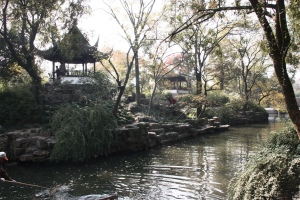Two roads diverged in a yellow wood,
And sorry I could not travel both
And be one traveler, long I stood
And looked down one as far as I could
To where it bent in the undergrowth;
Then took the other, as just as fair,
And having perhaps the better claim,
Because it was grassy and wanted wear;
Though as for that the passing there
Had worn them really about the same,
And both that morning equally lay
In leaves no step had trodden black.
Oh, I kept the first for another day!
Yet knowing how way leads on to way,
I doubted if I should ever come back.
I shall be telling this with a sigh
Somewhere ages and ages hence:
Two roads diverged in a wood, and I—
I took the one less traveled by,
And that has made all the difference.
The above poem, The Road Not Taken by Robert Frost, is a theme I found constant within the Humble Administrator’s Garden in Suzhou, China. If Japanese gardens are about sequence, borrowed scenery, and framed views while Korean gardens are about adding built into landscape while leaving nature as untouched as possible, Chinese gardens are about discovery. The Humble Administrator’s Garden is just that. Moments of contemplation and decisions that leads you to unexpected spaces. What I found most intriguing, in contrast to Japan and Korea where there is a defined path; here, you are able to wander and contemplate, to make your own path.
What made the Administrator’s Garden even more fascinating is its juxtaposition to Chinese architecture which is pretty strict. In the Forbidden City there is a distinct order of hierarchy and procession. Everything is dictated on movement from center axis to side entry/exit. The garden at the end of the Forbidden City is small and minuscule, emphasizing even more the non-importance of the garden to the overall procession. The same is experienced at the Temple of Heaven. There are no straight paths at the Administrator’s Garden. The only semblance of an axial progression at the entry but from that point it is a maze of split roads that go from high to low, then forward and back as you begin to experience the pavilions resting on top. Great examples of this are the bridges. Each one was a zigzag that did not allow for a moments easy walking. The moments of ease are only experienced at pavilions. The seats designed to make you look at the scenery beyond; this is the only time where anything is “dictated.”
Though Chinese gardens have a sense of freedom this does not mean that the spaces are not highly designed. There is a distinct play on soft versus hard within the space. There are moments of relief and moments of intensity. The notion of representation is introduced with naturally found rocks that stand on podiums and the rocks that created caves that compressed you and gave you the sense of moving through a mountain range. This break from the rigid is what made me thoroughly enjoy the garden. You saw a place where hierarchy was scratched and it became about the user and his journey. The one place were social class did not matter. In contrast to Japan where the gardens have a narrative that has been carved out for you and the discovery of the narrative is through the path you take from one frame to the next, the Administrator’s Garden left the narrative open for your own interpretation and allowed a sort of freedom that was seldom found in the manicured landscape of Japanese Gardens.
– Precious
Filed under: China, Gardens, Humble Administrator, Suzhou



